Cardiomyocyte-Specific Loss of Glutamyl-prolyl-tRNA Synthetase Leads to Disturbed Protein Homeostasis and Dilated Cardiomyopathy
Abstract
:1. Introduction
2. Materials and Methods
2.1. Mice
2.2. Transverse Aortic Constriction Mouse Model
2.3. Echocardiography
2.4. Wheat Germ Agglutinin (WGA) Staining
2.5. Picrosirius Red Staining
2.6. mRNA Expression by qRT-PCR
2.7. Immunoblotting
2.8. In Vivo Puromycin Incorporation Assay
2.9. Terminal Deoxynucleotidyl Transferase dUTP Nick End Labeling (TUNEL) Assay
2.10. RNA-Seq NGS Data Processing and Alignment
2.11. Quantitative Mass Spectrometry
2.12. Statistical Analysis
3. Results
3.1. Heterozygous Knockout of Cardiomyocyte Eprs1 Does Not Affect Cardiac Function at Baseline or under Pressure Overload in Mice
3.2. Homozygous Knockout of Eprs1 in Cardiomyocytes Leads to Dilated Cardiomyopathy and Heart Failure in Mice
3.3. Early-Stage Transcriptomic Changes Indicate Cardiac Pathological Remodeling in Cardiomyocyte-Specific Eprs1 Null Hearts
3.4. Eprs1 Loss of Function in Cardiomyocytes Triggers Proteomic Reprogramming in Mouse Hearts
3.5. Downregulation of Proline-Rich Proteins in Cardiomyocyte-Specific Eprs1-Depleted Hearts
4. Discussion
Supplementary Materials
Author Contributions
Funding
Institutional Review Board Statement
Informed Consent Statement
Data Availability Statement
Acknowledgments
Conflicts of Interest
References
- Yao, P.; Fox, P.L. Aminoacyl-tRNA synthetases in medicine and disease. EMBO Mol. Med. 2013, 5, 332–343. [Google Scholar] [CrossRef] [PubMed]
- Park, S.G.; Schimmel, P.; Kim, S. Aminoacyl tRNA synthetases and their connections to disease. Proc. Natl. Acad. Sci. USA 2008, 105, 11043–11049. [Google Scholar] [CrossRef] [PubMed]
- Wu, J.; Subbaiah, K.C.V.; Xie, L.H.; Jiang, F.; Khor, E.S.; Mickelsen, D.M.; Myers, J.R.; Tang, W.W.; Yao, P. Glutamyl-Prolyl-tRNA Synthetase Regulates Proline-Rich Pro-fibrotic Protein Synthesis During Cardiac Fibrosis. Circ. Res. 2020, 127, 827–846. [Google Scholar] [CrossRef] [PubMed]
- Yao, P.; Potdar, A.A.; Arif, A.; Ray, P.S.; Mukhopadhyay, R.; Willard, B.; Xu, Y.; Yan, J.; Saidel, G.M.; Fox, P.L. Coding region polyadenylation generates a truncated tRNA synthetase that counters translation repression. Cell 2012, 149, 88–100. [Google Scholar] [CrossRef] [PubMed]
- Yao, P.; Potdar, A.A.; Ray, P.S.; Eswarappa, S.M.; Flagg, A.C.; Willard, B.; Fox, P.L. The HILDA complex coordinates a conditional switch in the 3′-untranslated region of the VEGFA mRNA. PLoS Biol. 2013, 11, e1001635. [Google Scholar] [CrossRef] [PubMed]
- Han, J.M.; Lee, M.J.; Park, S.G.; Lee, S.H.; Razin, E.; Choi, E.C.; Kim, S. Hierarchical network between the components of the multi-tRNA synthetase complex: Implications for complex formation. J. Biol. Chem. 2006, 281, 38663–38667. [Google Scholar] [CrossRef]
- Qin, P.; Arabacilar, P.; Bernard, R.E.; Bao, W.; Olzinski, A.R.; Guo, Y.; Lal, H.; Eisennagel, S.H.; Platchek, M.C.; Xie, W.; et al. Activation of the Amino Acid Response Pathway Blunts the Effects of Cardiac Stress. J. Am. Heart Assoc. 2017, 6, e004453. [Google Scholar] [CrossRef]
- Sandoval, D.R.; Clausen, T.M.; Nora, C.; Cribbs, A.P.; Denardo, A.; Clark, A.E.; Garretson, A.F.; Coker, J.K.C.; Narayanan, A.; Majowicz, S.A.; et al. The Prolyl-tRNA Synthetase Inhibitor Halofuginone Inhibits SARS-CoV-2 Infection. bioRxiv 2021. [Google Scholar] [CrossRef]
- Yoon, I.; Kim, S.; Cho, M.; You, K.A.; Son, J.; Lee, C.; Suh, J.H.; Bae, D.J.; Kim, J.M.; Oh, S.; et al. Control of fibrosis with enhanced safety via asymmetric inhibition of prolyl-tRNA synthetase 1. EMBO Mol. Med. 2023, 15, e16940. [Google Scholar] [CrossRef]
- Luo, Y.; Xie, X.; Luo, D.; Wang, Y.; Gao, Y. The role of halofuginone in fibrosis: More to be explored? J. Leukoc. Biol. 2017, 102, 1333–1345. [Google Scholar] [CrossRef]
- Zhou, H.; Sun, L.; Yang, X.L.; Schimmel, P. ATP-directed capture of bioactive herbal-based medicine on human tRNA synthetase. Nature 2013, 494, 121–124. [Google Scholar] [CrossRef]
- Wu, J.; Venkata Subbaiah, K.C.; Jiang, F.; Hedaya, O.; Mohan, A.; Yang, T.; Welle, K.; Ghaemmaghami, S.; Tang, W.H.W.; Small, E.; et al. MicroRNA-574 regulates FAM210A expression and influences pathological cardiac remodeling. EMBO Mol. Med. 2021, 13, e12710. [Google Scholar] [CrossRef] [PubMed]
- Bolger, A.M.; Lohse, M.; Usadel, B. Trimmomatic: A flexible trimmer for Illumina sequence data. Bioinformatics 2014, 30, 2114–2120. [Google Scholar] [CrossRef] [PubMed]
- Kim, D.; Paggi, J.M.; Park, C.; Bennett, C.; Salzberg, S.L. Graph-based genome alignment and genotyping with HISAT2 and HISAT-genotype. Nat. Biotechnol. 2019, 37, 907–915. [Google Scholar] [CrossRef] [PubMed]
- Liao, Y.; Smyth, G.K.; Shi, W. featureCounts: An efficient general purpose program for assigning sequence reads to genomic features. Bioinformatics 2014, 30, 923–930. [Google Scholar] [CrossRef]
- Frankish, A.; Diekhans, M.; Jungreis, I.; Lagarde, J.; Loveland, J.E.; Mudge, J.M.; Sisu, C.; Wright, J.C.; Armstrong, J.; Barnes, I.; et al. GENCODE 2021. Nucleic Acids Res. 2021, 49, D916–D923. [Google Scholar] [CrossRef] [PubMed]
- Love, M.I.; Huber, W.; Anders, S. Moderated estimation of fold change and dispersion for RNA-seq data with DESeq2. Genome Biol. 2014, 15, 550. [Google Scholar] [CrossRef] [PubMed]
- Team RCR. A Language and Environment for Statistical Computing; R Foundation for Statistical Computing: Vienna, Austria, 2020; Available online: https://www.R-project.org/ (accessed on 1 December 2022).
- Xie, Z.; Bailey, A.; Kuleshov, M.V.; Clarke, D.J.B.; Evangelista, J.E.; Jenkins, S.L.; Lachmann, A.; Wojciechowicz, M.L.; Kropiwnicki, E.; Jagodnik, K.M.; et al. Gene Set Knowledge Discovery with Enrichr. Curr. Protoc. 2021, 1, e90. [Google Scholar] [CrossRef]
- Sherman, B.T.; Hao, M.; Qiu, J.; Jiao, X.; Baseler, M.W.; Lane, H.C.; Imamichi, T.; Chang, W. DAVID: A web server for functional enrichment analysis and functional annotation of gene lists (2021 update). Nucleic Acids Res. 2022, 50, W216–W221. [Google Scholar] [CrossRef]
- Subbaiah, K.C.V.; Wu, J.; Tang, W.H.W.; Yao, P. Ciclopirox Inhibition of eIF5A Hypusination Attenuates Fibroblast Activation and Cardiac Fibrosis. J. Cardiovasc. Dev. Dis. 2023, 10, 52. [Google Scholar] [CrossRef]
- Skarnes, W.C.; Rosen, B.; West, A.P.; Koutsourakis, M.; Bushell, W.; Iyer, V.; Mujica, A.O.; Thomas, M.; Harrow, J.; Cox, T.; et al. A conditional knockout resource for the genome-wide study of mouse gene function. Nature 2011, 474, 337–342. [Google Scholar] [CrossRef] [PubMed]
- Sohal, D.S.; Nghiem, M.; Crackower, M.A.; Witt, S.A.; Kimball, T.R.; Tymitz, K.M.; Penninger, J.M.; Molkentin, J.D. Temporally regulated and tissue-specific gene manipulations in the adult and embryonic heart using a tamoxifen-inducible Cre protein. Circ. Res. 2001, 89, 20–25. [Google Scholar] [CrossRef] [PubMed]
- Lopaschuk, G.D.; Karwi, Q.G.; Tian, R.; Wende, A.R.; Abel, E.D. Cardiac Energy Metabolism in Heart Failure. Circ. Res. 2021, 128, 1487–1513. [Google Scholar] [CrossRef] [PubMed]
- Mirande, M. The Aminoacyl-tRNA Synthetase Complex. Subcell. Biochem. 2017, 83, 505–522. [Google Scholar] [PubMed]
- Kong, J.; Kim, S. Cell-based analysis of pairwise interactions between the components of the multi-tRNA synthetase complex. FASEB J. 2020, 34, 10476–10488. [Google Scholar] [CrossRef]
- Thoreen, C.C.; Chantranupong, L.; Keys, H.R.; Wang, T.; Gray, N.S.; Sabatini, D.M. A unifying model for mTORC1-mediated regulation of mRNA translation. Nature 2012, 485, 109–113. [Google Scholar] [CrossRef]
- Jin, D.; Wek, S.A.; Kudlapur, N.T.; Cantara, W.A.; Bakhtina, M.; Wek, R.C.; Musier-Forsyth, K. Disease-associated mutations in a bifunctional aminoacyl-tRNA synthetase gene elicit the integrated stress response. J. Biol. Chem. 2021, 297, 101203. [Google Scholar] [CrossRef]
- Yemni, E.A.; Monies, D.; Alkhairallah, T.; Bohlega, S.; Abouelhoda, M.; Magrashi, A.; Mustafa, A.; AlAbdulaziz, B.; Alhamed, M.; Baz, B.; et al. Integrated Analysis of Whole Exome Sequencing and Copy Number Evaluation in Parkinson’s Disease. Sci. Rep. 2019, 9, 3344. [Google Scholar] [CrossRef]
- Mendes, M.I.; Gutierrez Salazar, M.; Guerrero, K.; Thiffault, I.; Salomons, G.S.; Gauquelin, L.; Tran, L.T.; Forget, D.; Gauthier, M.S.; Waisfisz, Q.; et al. Bi-allelic Mutations in EPRS, Encoding the Glutamyl-Prolyl-Aminoacyl-tRNA Synthetase, Cause a Hypomyelinating Leukodystrophy. Am. J. Hum. Genet. 2018, 102, 676–684. [Google Scholar] [CrossRef]
- Gill, J.; Sharma, A. Prospects of halofuginone as an antiprotozoal drug scaffold. Drug Discov. Today 2022, 27, 2586–2592. [Google Scholar] [CrossRef]
- Song, D.G.; Kim, D.; Jung, J.W.; Nam, S.H.; Kim, J.E.; Kim, H.J.; Kim, J.H.; Pan, C.H.; Kim, S.; Lee, J.W. Glutamyl-Prolyl-tRNA Synthetase Regulates Epithelial Expression of Mesenchymal Markers and Extracellular Matrix Proteins: Implications for Idiopathic Pulmonary Fibrosis. Front. Pharmacol. 2018, 9, 1337. [Google Scholar] [CrossRef] [PubMed]
- Song, D.G.; Kim, D.; Jung, J.W.; Nam, S.H.; Kim, J.E.; Kim, H.J.; Kim, J.H.; Lee, S.J.; Pan, C.H.; Kim, S.; et al. Glutamyl-prolyl-tRNA synthetase induces fibrotic extracellular matrix via both transcriptional and translational mechanisms. FASEB J. 2019, 33, 4341–4354. [Google Scholar] [CrossRef] [PubMed]
- Chen, M.S.; Lee, R.T.; Garbern, J.C. Senescence mechanisms and targets in the heart. Cardiovasc. Res. 2022, 118, 1173–1187. [Google Scholar] [CrossRef] [PubMed]
- Khan, K.; Long, B.; Gogonea, V.; Deshpande, G.M.; Vasu, K.; Fox, P.L. Multimodal cotranslational interactions direct assembly of the human multi-tRNA synthetase complex. Proc. Natl. Acad. Sci. USA 2022, 119, e2205669119. [Google Scholar] [CrossRef] [PubMed]
- Han, J.; Back, S.H.; Hur, J.; Lin, Y.H.; Gildersleeve, R.; Shan, J.; Yuan, C.L.; Krokowski, D.; Wang, S.; Hatzoglou, M.; et al. ER-stress-induced transcriptional regulation increases protein synthesis leading to cell death. Nat. Cell Biol. 2013, 15, 481–490. [Google Scholar] [CrossRef]
- Milenkovic, I.; Santos Vieira, H.G.; Lucas, M.C.; Ruiz-Orera, J.; Patone, G.; Kesteven, S.; Wu, J.; Feneley, M.; Espadas, G.; Sabido, E.; et al. Dynamic interplay between RPL3- and RPL3L-containing ribosomes modulates mitochondrial activity in the mammalian heart. Nucleic Acids Res. 2023, 51, 5301–5324. [Google Scholar] [CrossRef]
- Shiraishi, C.; Matsumoto, A.; Ichihara, K.; Yamamoto, T.; Yokoyama, T.; Mizoo, T.; Hatano, A.; Matsumoto, M.; Tanaka, Y.; Matsuura-Suzuki, E.; et al. RPL3L-containing ribosomes determine translation elongation dynamics required for cardiac function. Nat. Commun. 2023, 14, 2131. [Google Scholar] [CrossRef]
- Hay, N.; Sonenberg, N. Upstream and downstream of mTOR. Genes. Dev. 2004, 18, 1926–1945. [Google Scholar] [CrossRef]
- Costa-Mattioli, M.; Walter, P. The integrated stress response: From mechanism to disease. Science 2020, 368, eaat5314. [Google Scholar] [CrossRef]
- Arif, A.; Terenzi, F.; Potdar, A.A.; Jia, J.; Sacks, J.; China, A.; Halawani, D.; Vasu, K.; Li, X.; Brown, J.M.; et al. EPRS is a critical mTORC1-S6K1 effector that influences adiposity in mice. Nature 2017, 542, 357–361. [Google Scholar] [CrossRef]
- Vasu, K.; Ramachandiran, I.; Terenzi, F.; Khan, D.; China, A.; Khan, K.; Chechi, A.; Baleanu-Gogonea, C.; Gogonea, V.; Fox, P.L. The zinc-binding domain of mammalian prolyl-tRNA synthetase is indispensable for catalytic activity and organism viability. iScience 2021, 24, 102215. [Google Scholar] [CrossRef] [PubMed]
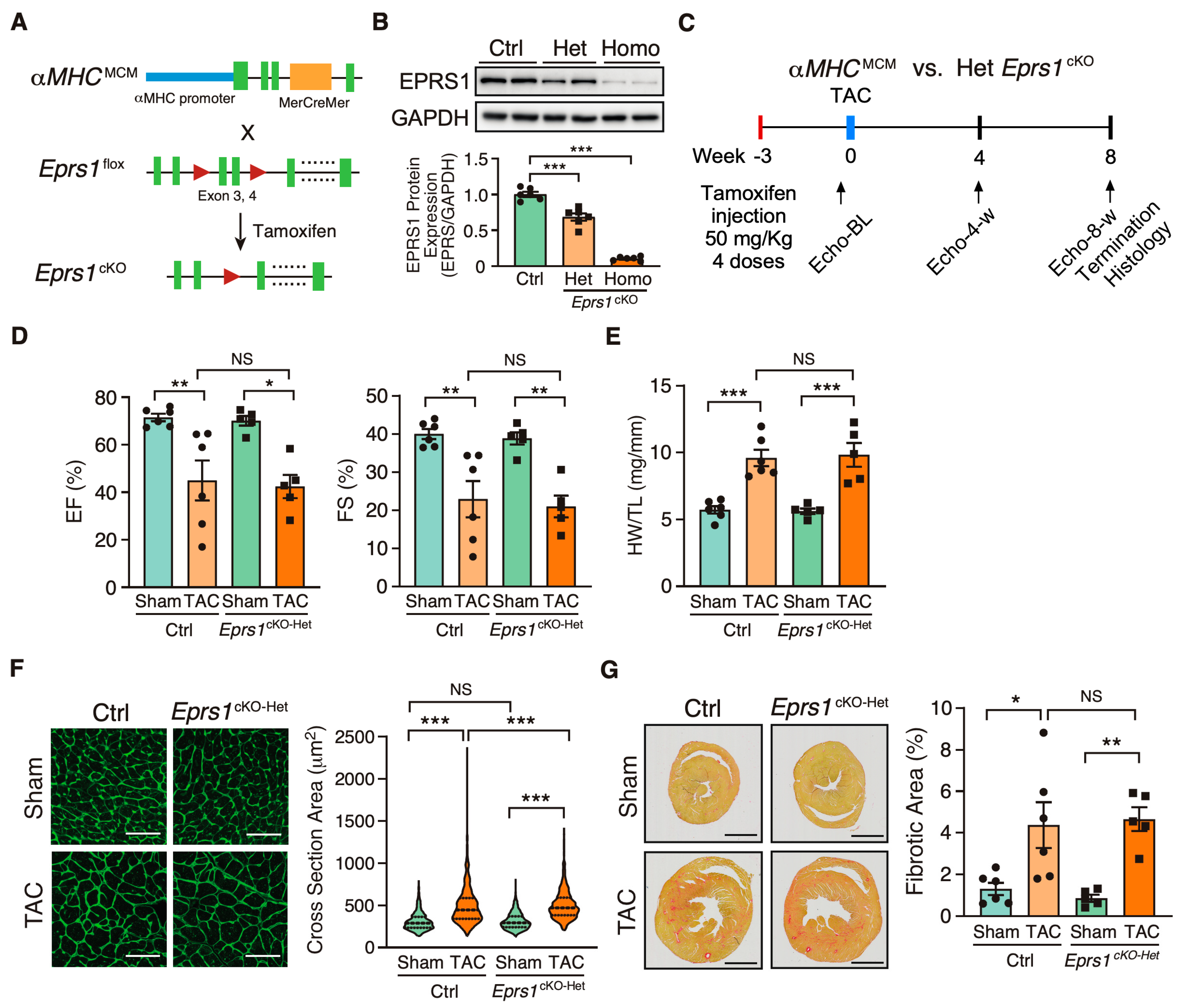
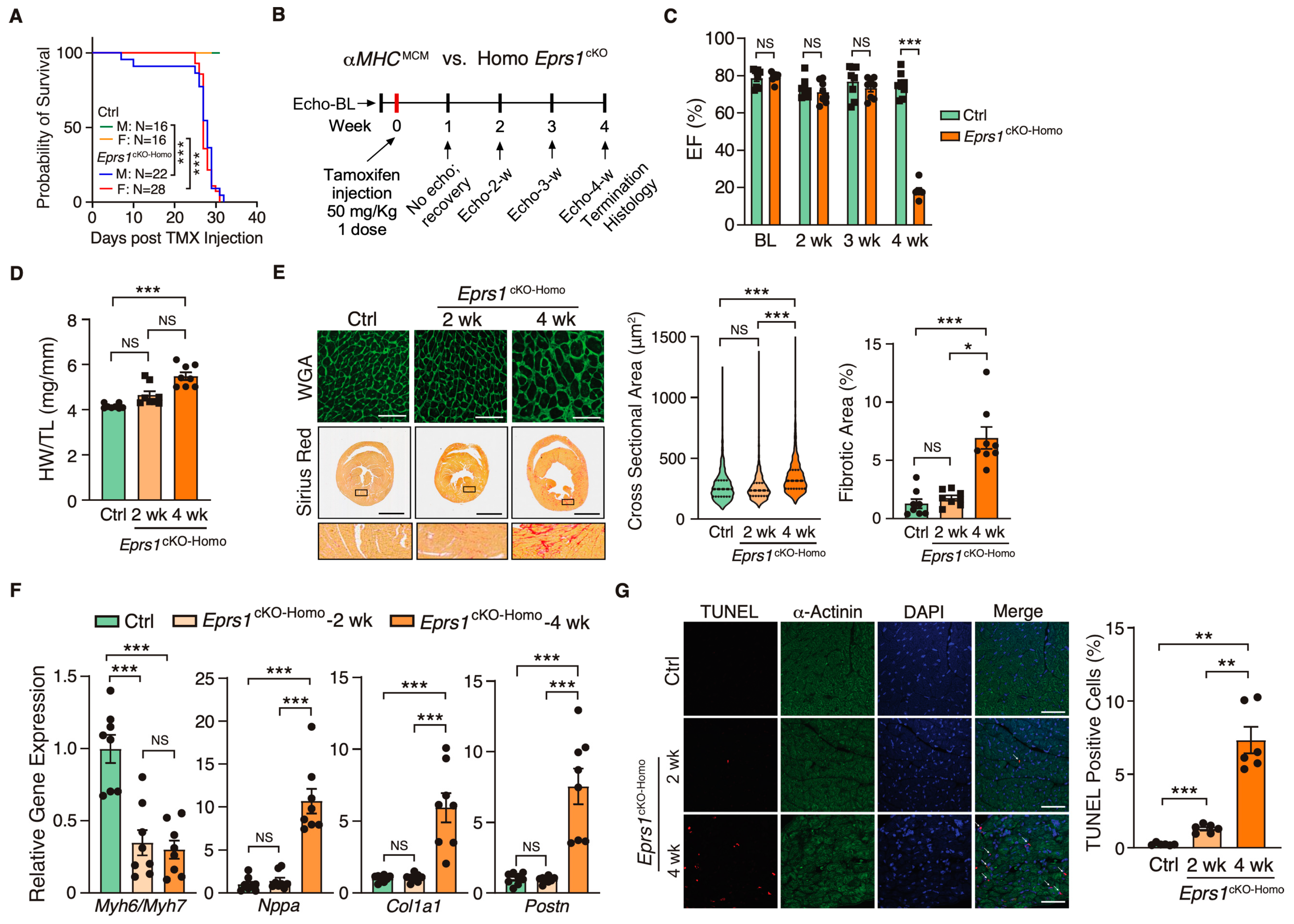
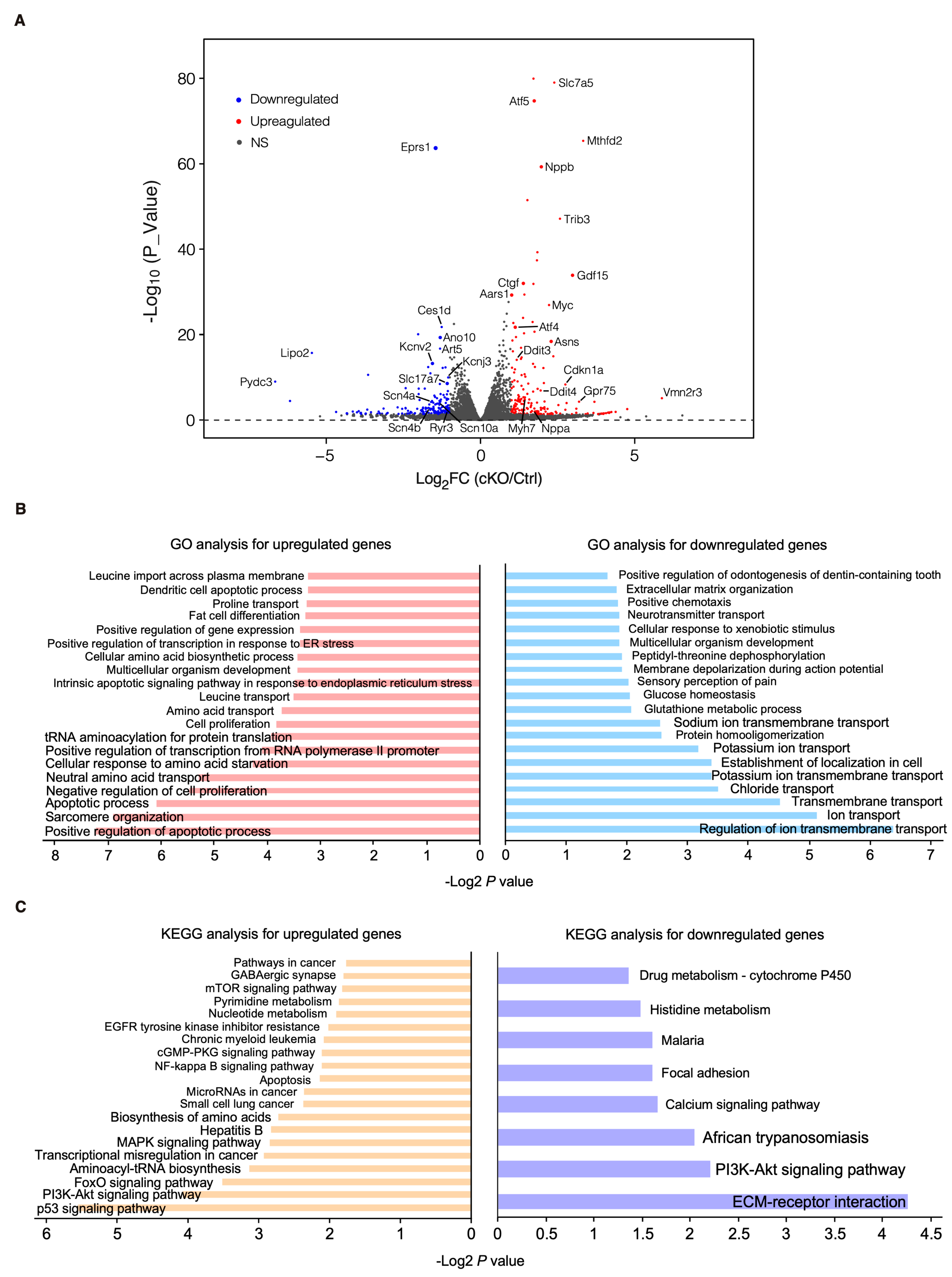
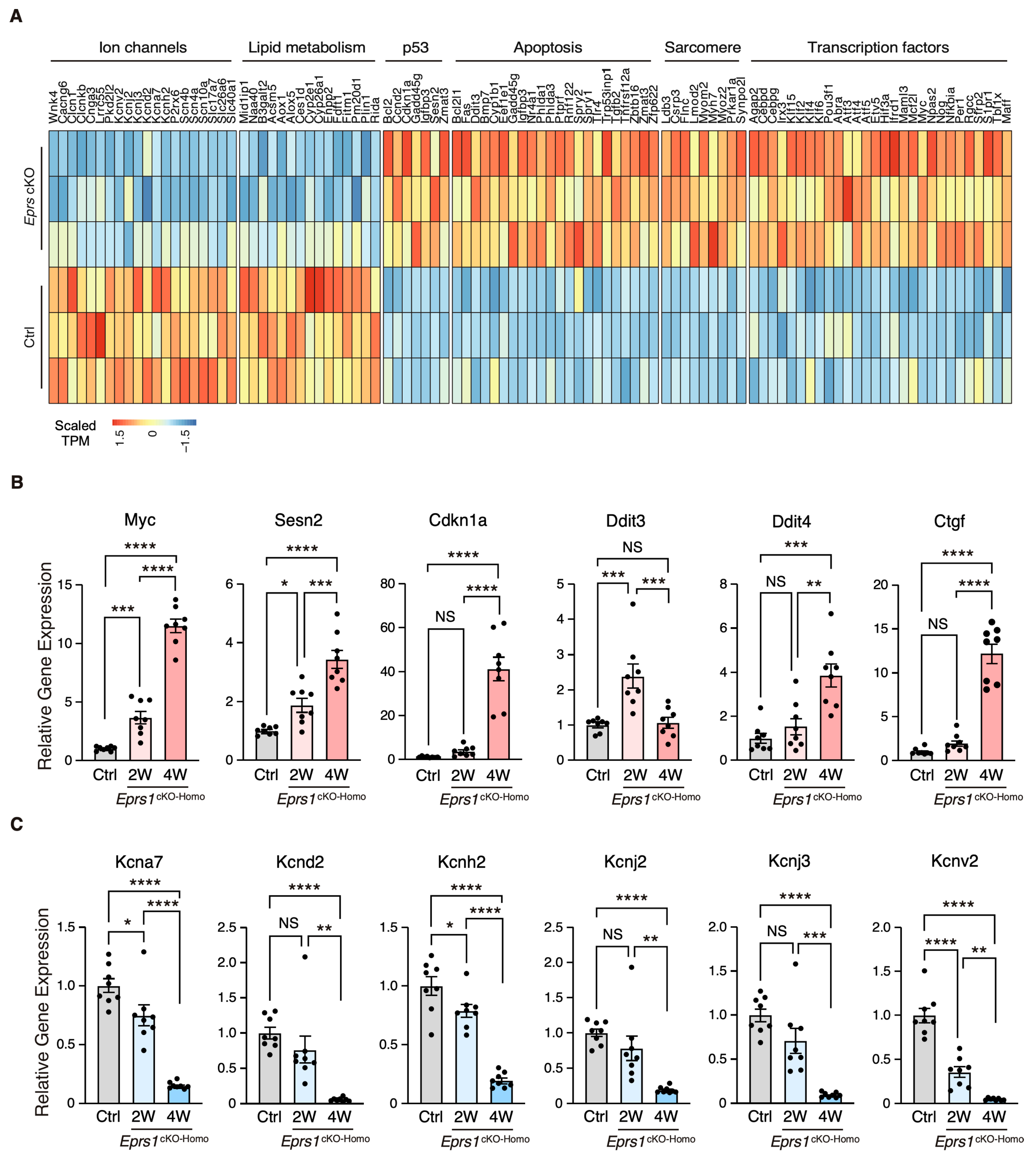
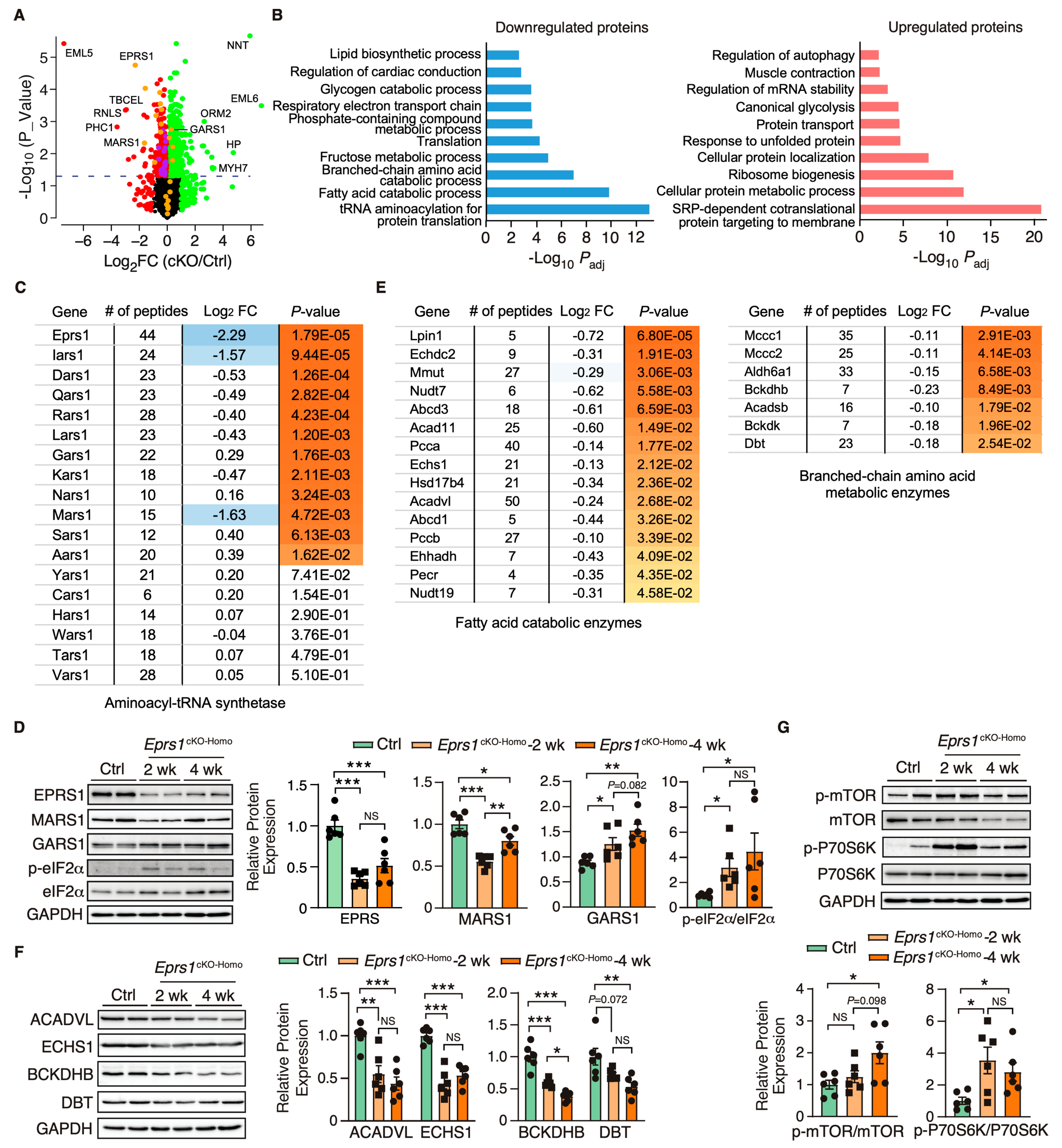
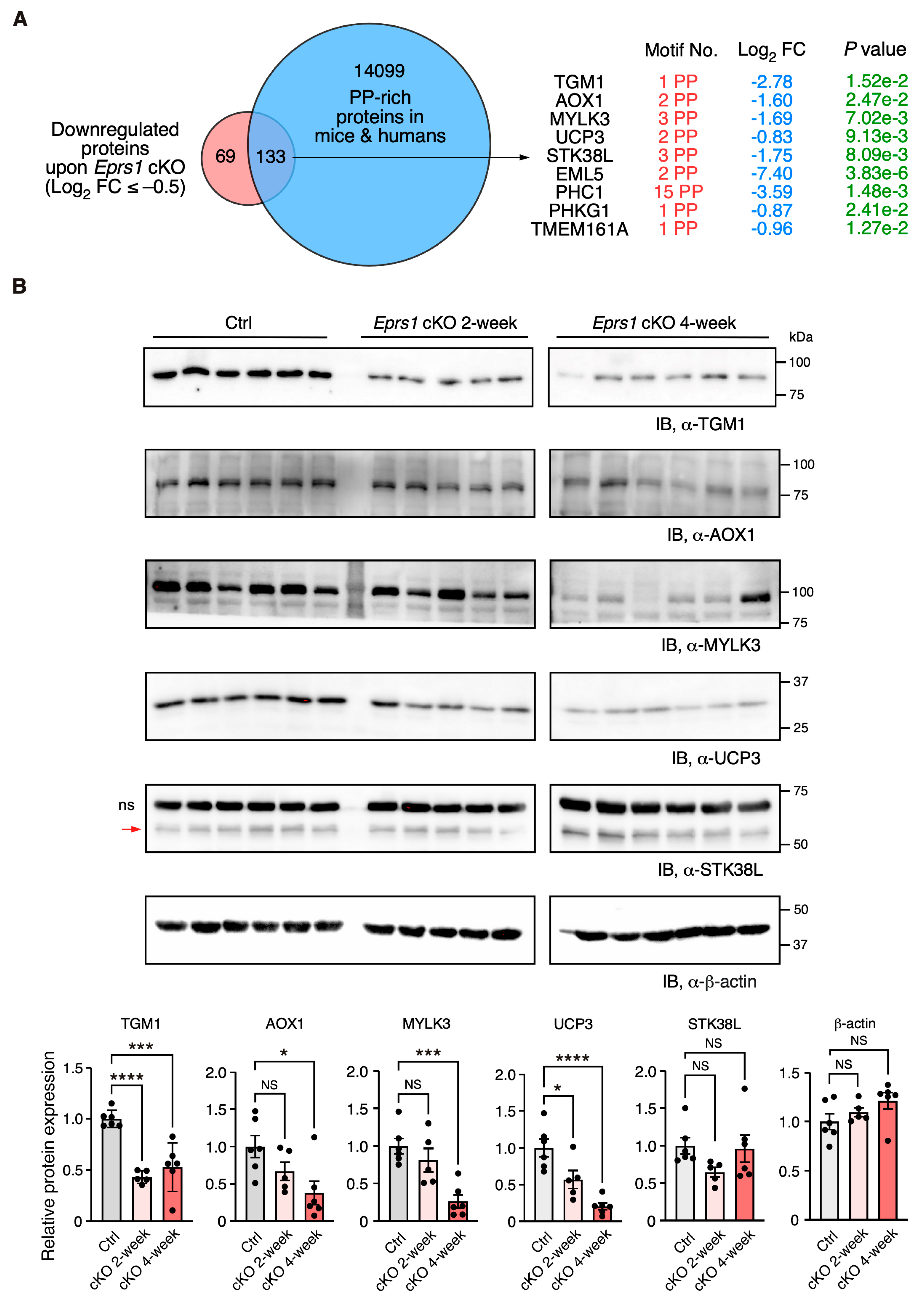
| Parameter | Sham | TAC | ||
|---|---|---|---|---|
| Ctrl (N = 6) | Eprs cKO-Het (N = 5) | Ctrl (N = 6) | Eprs cKO-Het (N = 5) | |
| Heart Rate (bpm) | 616.86 ± 27.79 | 626.34 ± 21.24 | 598.83 ± 8.32 | 566.62 ± 21.16 |
| Internal Diameter, Systole (mm) | 2.1 ± 0.04 | 2.14 ± 0.11 | 3.23 ± 0.5 | 3.56 ± 0.32 # |
| Internal Diameter, Diastole (mm) | 3.5 ± 0.07 | 3.5 ± 0.18 | 4.09 ± 0.38 | 4.49 ± 0.29 |
| Volume; Systole (mL) | 14.5 ± 0.65 | 15.43 ± 1.84 | 50.05 ± 19.31 | 55.85 ± 13.07 |
| Volume; Diastole (mL) | 51.1 ± 2.63 | 51.92 ± 6.25 | 78.64 ± 18.88 *** | 94.16 ± 14.92 ##;$$ |
| Stroke Volume (mL) | 36.6 ± 2.43 | 36.49 ± 4.76 | 28.59 ± 2.11 | 38.31 ± 4.7 |
| Ejection Fraction (%) | 71.4 ± 1.54 | 70.06 ± 2.01 | 44.91 ± 8.41 ** | 42.34 ± 4.91 # |
| Fractional Shortening (%) | 39.97 ± 1.32 | 38.81 ± 1.6 | 22.88 ± 4.78 ** | 20.95 ± 2.85 ## |
| Cardiac Output (mL/min) | 22.57 ± 1.67 | 22.69 ± 2.83 | 17.07 ± 1.13 | 21.73 ± 2.88 |
| LV Mass (mg) | 76.84 ± 4.22 | 72.27 ± 3.44 | 149.5 ± 19.16 ** | 181.12 ± 16.09 ### |
| LV Mass Cor (mg) | 61.47 ± 3.38 | 57.81 ± 2.76 | 119.6 ± 15.33 ** | 144.9 ± 12.87 ### |
| LV Anterior Wall Diameter, Systole (mm) | 1.05 ± 0.04 | 1.01 ± 0.07 | 1.26 ± 0.06 * | 1.27 ± 0.04 # |
| LV Anterior Wall Diameter, Diastole (mm) | 0.73 ± 0.05 | 0.73 ± 0.05 | 1.03 ± 0.05 ** | 1.04 ± 0.05 ## |
| LV Posterior Wall Diameter, Systole (mm) | 1.07 ± 0.05 | 1.02 ± 0.04 | 0.98 ± 0.09 | 1.06 ± 0.07 |
| LV Posterior Wall Diameter, Diastole (mm) | 0.65 ± 0.02 | 0.6 ± 0.05 | 0.82 ± 0.06 | 0.87 ± 0.05 ## |
| Parameter | Ctrl (N = 8) | Eprs cKO -Homo (N = 8) | Ctrl (N = 8) | Eprs cKO -Homo (N = 8) | Ctrl (N = 8) | Eprs cKO -Homo (N = 8) | Ctrl (N = 8) | Eprs cKO -Homo (N = 7) |
|---|---|---|---|---|---|---|---|---|
| BL | 2 Week | 3 Week | 4 Week | |||||
| Heart Rate (bpm) | 542.9 ± 7.97 | 572.51 ± 9.94 * | 562.41 ± 9.84 | 590.92 ± 14.85 | 564.01 ± 18.21 | 578.91 ± 7.46 | 559.94 ± 15.38 | 516.9 ± 35.09 |
| Internal Diameter, Systole (mm) | 1.85 ± 0.04 | 1.77 ± 0.05 | 1.93 ± 0.09 | 2.08 ± 0.12 | 1.81 ± 0.11 | 2.03 ± 0.10 | 1.93 ± 0.05 | 4.41 ± 0.15 **** |
| Internal Diameter, Diastole (mm) | 3.48 ± 0.05 | 3.33 ± 0.05 * | 3.44 ± 0.13 | 3.43 ± 0.11 | 3.33 ± 0.13 | 3.46 ± 0.08 | 3.51 ± 0.06 | 4.8 ± 0.14 **** |
| Volume; Systole (mL) | 10.41 ± 0.61 | 9.50 ± 0.70 | 11.94 ± 1.28 | 14.68 ± 2.05 | 10.17 ± 1.48 | 13.63 ± 1.77 | 11.62 ± 0.84 | 88.86 ± 6.87 **** |
| Volume; Diastole (mL) | 50.15 ± 1.61 | 45.16 ± 1.73 | 49.43 ± 4.12 | 49.00 ± 3.83 | 45.72 ± 4.04 | 49.70 ± 2.89 | 51.21 ± 1.95 | 108.36 ± 7.49 **** |
| Stroke Volume (mL) | 39.4 ± 1.41 | 35.66 ± 1.14 | 35.67 ± 2.52 | 34.32 ± 1.86 | 34.63 ± 2.73 | 36.08 ± 1.23 | 38.36 ± 1.79 | 19.5 ± 1.52 **** |
| Ejection Fraction (%) | 78.63 ± 1.72 | 79.14 ± 0.86 | 73.13 ± 1.84 | 71.09 ± 2.06 | 76.75 ± 3.06 | 73.33 ± 1.96 | 75.02 ± 2.30 | 18.23 ± 1.57 **** |
| Fractional Shortening (%) | 46.46 ± 1.43 | 46.71 ± 0.79 | 42.05 ± 1.42 | 39.7 ± 1.64 | 44.98 ± 2.37 | 41.65 ± 1.63 | 43.61 ± 1.85 | 8.26 ± 0.75 **** |
| Cardiac Output (mL/min) | 22.9 ± 0.94 | 20.35 ± 0.47 * | 21.37 ± 1.40 | 20.23 ± 1.09 | 20.98 ± 1.99 | 20.84 ± 0.58 | 22.96 ± 1.22 | 9.89 ± 0.97 **** |
| LV Mass (mg) | 77.45 ± 5.08 | 62.31 ± 2.62 * | 88.24 ± 6.11 | 79.08 ± 4.65 | 76.38 ± 6.28 | 75.94 ± 1.92 | 88.09 ± 4.80 | 108.23 ± 6.03 * |
| LV Mass Cor (mg) | 61.96 ± 4.07 | 49.85 ± 2.09 * | 70.59 ± 4.89 | 63.26 ± 3.72 | 61.10 ± 5.03 | 60.75 ± 1.53 | 70.47 ± 3.84 | 86.58 ± 4.82 * |
| LV Anterior Wall Diameter, Systole (mm) | 1.26 ± 0.06 | 1.07 ± 0.02 ** | 1.40 ± 0.05 | 1.19 ± 0.03 ** | 1.33 ± 0.05 | 1.17 ± 0.02 ** | 1.35 ± 0.06 | 0.74 ± 0.02 **** |
| LV Anterior Wall Diameter, Diastole (mm) | 0.81 ± 0.03 | 0.69 ± 0.02 ** | 0.90 ± 0.04 | 0.79 ± 0.02* | 0.83 ± 0.04 | 0.78 ± 0.02 | 0.85 ± 0.04 | 0.70 ± 0.03 * |
| LV Posterior Wall Diameter, Systole (mm) | 1.02 ± 0.03 | 0.92 ± 0.02 * | 1.03 ± 0.04 | 0.92 ± 0.03 * | 1.02 ± 0.05 | 0.90 ± 0.03 * | 1.02 ± 0.03 | 0.57 ± 0.03 **** |
| LV Posterior Wall Diameter, Diastole (mm) | 0.56 ± 0.02 | 0.56 ± 0.02 | 0.63 ± 0.02 | 0.64 ± 0.04 | 0.60 ± 0.04 | 0.60 ± 0.03 | 0.63 ± 0.03 | 0.48 ± 0.03 ** |
Disclaimer/Publisher’s Note: The statements, opinions and data contained in all publications are solely those of the individual author(s) and contributor(s) and not of MDPI and/or the editor(s). MDPI and/or the editor(s) disclaim responsibility for any injury to people or property resulting from any ideas, methods, instructions or products referred to in the content. |
© 2023 by the authors. Licensee MDPI, Basel, Switzerland. This article is an open access article distributed under the terms and conditions of the Creative Commons Attribution (CC BY) license (https://creativecommons.org/licenses/by/4.0/).
Share and Cite
Wu, J.; Hollinger, J.; Bonanno, E.; Jiang, F.; Yao, P. Cardiomyocyte-Specific Loss of Glutamyl-prolyl-tRNA Synthetase Leads to Disturbed Protein Homeostasis and Dilated Cardiomyopathy. Cells 2024, 13, 35. https://doi.org/10.3390/cells13010035
Wu J, Hollinger J, Bonanno E, Jiang F, Yao P. Cardiomyocyte-Specific Loss of Glutamyl-prolyl-tRNA Synthetase Leads to Disturbed Protein Homeostasis and Dilated Cardiomyopathy. Cells. 2024; 13(1):35. https://doi.org/10.3390/cells13010035
Chicago/Turabian StyleWu, Jiangbin, Jared Hollinger, Emily Bonanno, Feng Jiang, and Peng Yao. 2024. "Cardiomyocyte-Specific Loss of Glutamyl-prolyl-tRNA Synthetase Leads to Disturbed Protein Homeostasis and Dilated Cardiomyopathy" Cells 13, no. 1: 35. https://doi.org/10.3390/cells13010035
APA StyleWu, J., Hollinger, J., Bonanno, E., Jiang, F., & Yao, P. (2024). Cardiomyocyte-Specific Loss of Glutamyl-prolyl-tRNA Synthetase Leads to Disturbed Protein Homeostasis and Dilated Cardiomyopathy. Cells, 13(1), 35. https://doi.org/10.3390/cells13010035







